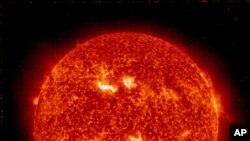|
Solar Storm Facts |
|
A massive solar storm initially expected to create havoc for everything from mobile phones to airline flights has reached Earth with little effect, but experts say that could still change.
The storm appeared to spare satellite and power systems as it shook the Earth's magnetic field Thursday, with no reports of GPS or power disruptions. A scientist with the U.S. National Oceanic and Atmospheric Administration, Joseph Kunches, said the storm struck in a direction that causes the least amount of problems. But he said that orientation could change as the storm continues.
The storm started with a pair of solar flares Tuesday, and continued with two coronal mass ejections that sent massive amounts of energy and charged particles shooting out of the sun.
The particles were expected to strike the Earth at a speed of more than six million kilometers per hour. Forecasters had warned the storm could disrupt radio communications, satellite networks, global positioning systems and electricity grids. Some airlines even moved to reroute their flights to avoid problems. But ultimately, the storm ended up registering at the lowest intensity on a five-level scale.
The storm also carries the potential to produce brilliant auroras, known as the Northern and Southern Lights, which occur as the particles from the solar ejection mix with the Earth's magnetic fields.
Scientists say the storm is part of the sun's normal 11-year cycle, when activity on the surface rises to its peak level. A strong storm in 1989 knocked out the power grid in Quebec, leaving millions of residents without electricity.
The U.S. space agency NASA had said it did not believe the storm would affect the International Space Station or its six-member crew.
Some information for this report was provided by AFP, AP and Reuters.







